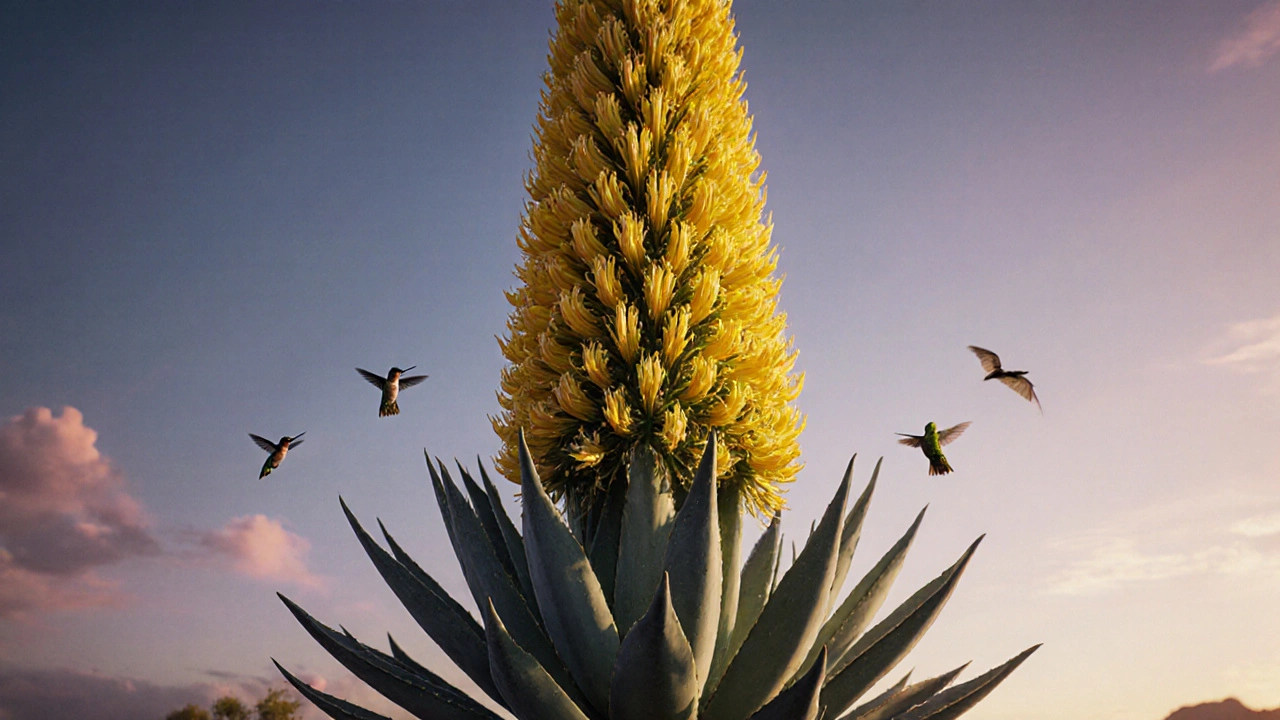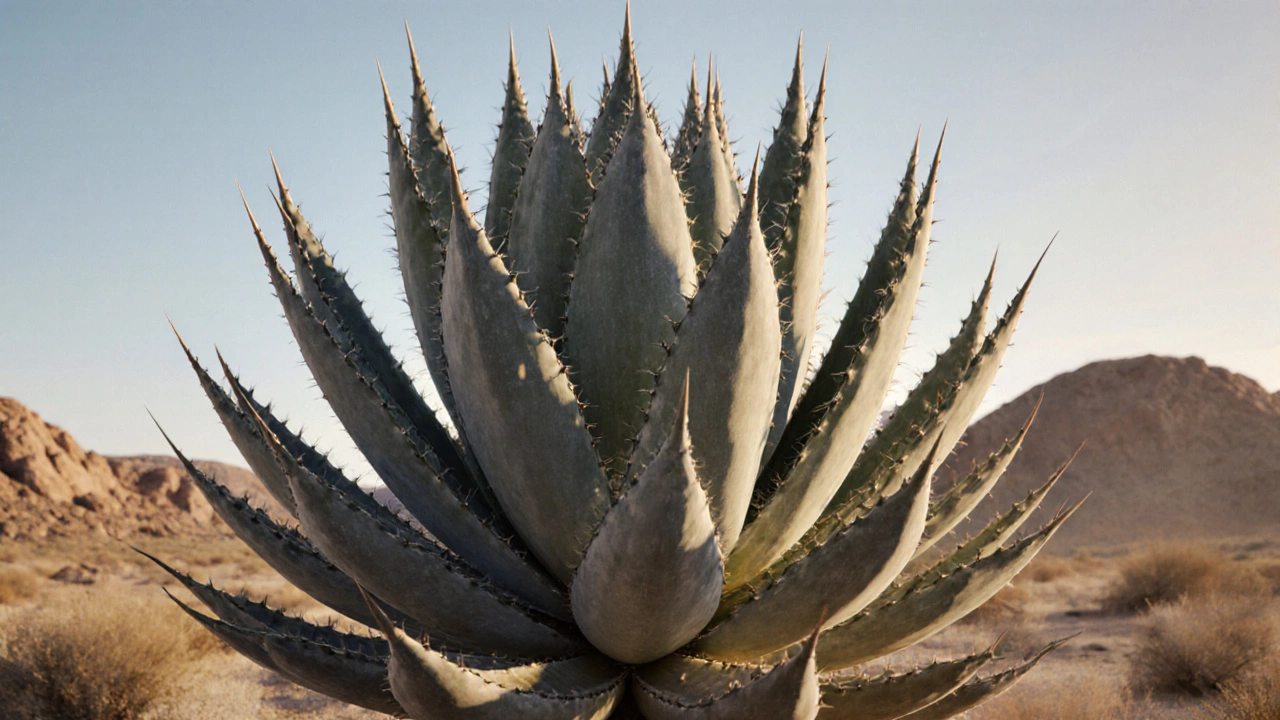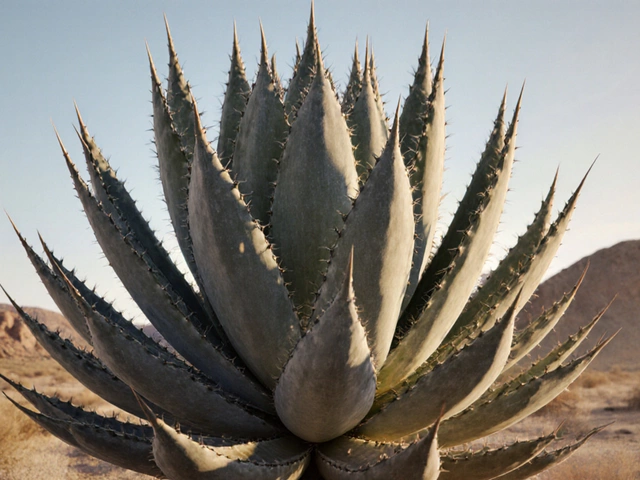Century Plant Bloom Calculator
Expected Bloom Characteristics
Years
Bloom Age
Meters
Stalk Height
Comparison with Other Long-Lived Succulents
Agave americana
30-40 years
5-10 m
Agave sisalana
~12 years
3-5 m
Puya raimondii
80-100 years
10-12 m
Aloe ferox
5-10 years
1-2 m
When you hear a plant that waits four decades to flower, you probably picture a mythic giant. The reality is the Agave americana, commonly called the century plant, actually takes about 30‑40 years before it sends up a towering stalk and blooms just once before dying.
TL;DR - Quick Facts
- Agave americana is the plant that typically blooms after 30‑40 years.
- It grows a massive flower stalk up to 10m (30ft) tall.
- After flowering, the main rosette dies, but pups can be harvested for new plants.
- It thrives in hot, dry climates with well‑draining soil.
- Other long‑lived succulents (Puya raimondii, Agave sisalana) also take many years to flower.
What is Agave americana?
Agave americana is a perennial succulent native to Mexico and the southern United States. It belongs to the Agavaceae family, which includes over 200 species of rosette‑forming plants. The plant forms a large, fleshy rosette of thick, sword‑shaped leaves that can reach 2m across.
Because of its striking architecture and low water needs, gardeners often use it as a focal point in xeriscapes, Mediterranean gardens, and even large container displays.
Why Does It Wait 40 Years?
The long waiting period is an evolutionary strategy. In arid environments, the plant stores massive amounts of energy in its leaves and roots. Only when the stored reserves are sufficient does it allocate resources to a reproductive effort-a process called monocarpic flowering. This single, massive reproductive event maximizes seed dispersal and ensures the species’ continuation.
During the pre‑flowering years, the plant focuses on leaf growth, root expansion, and water storage. Once conditions are favorable-usually after several decades of stable climate-the plant initiates a hormonal cascade (primarily involving gibberellins) that triggers the growth of a flowering stalk.
Growing Agave americana: Soil, Light, and Water
To successfully cultivate a century plant, give it the environment it mimics in the wild.
- Sunlight: Full sun to light shade; at least 6hours of direct sunlight daily.
- Soil: Rocky, gritty, and well‑draining. A mix of 50% coarse sand, 30% garden soil, and 20% perlite works well.
- Watering: In the first year, water lightly until established. After that, water only during prolonged droughts-over‑watering can cause root rot.
- Temperature: Hardy to about -10°C (14°F) once mature, but young plants need protection from frost.
Fertilize sparingly-once a year with a low‑nitrogen, high‑phosphorus fertilizer-to encourage strong root development without excessive foliage.

What Happens When It Blooms?
After decades of growth, a giant stalk-called the inflorescence-shoots from the center of the rosette. The stalk can reach 5‑10m tall and bears hundreds of yellow, tubular flowers that open sequentially over several weeks.
These flowers attract a range of pollinators: hummingbirds, bats, and large insects. Once pollination is complete, the plant produces woody seed pods that eventually split open, scattering the tiny seeds.
At this point, the original rosette begins to die back. However, the plant often produces offsets, called "pups," at the base. Those pups can be separated and replanted, continuing the life cycle.
Managing the Plant After Bloom
If you prefer not to wait another 40 years for a new bloom, you can propagate the offsets.
- Wait until the flower stalk has withered and the rosette has started to decay.
- Locate healthy pups at the base-look for smaller rosettes with well‑developed roots.
- Use a sharp, sterilized knife to cut the pup away, keeping as much root as possible.
- Let the cut end dry for a day to form a callus, then plant in a well‑draining mix.
- Water lightly after planting and keep in bright light; the new plant will take several years to reach maturity.
Removing the dying rosette also reduces the risk of fungal infections in the surrounding garden.
Other Long‑Lived Succulents (Quick Comparison)
| Plant | Typical Bloom Age | Stalk Height | Native Climate | Propagation Method |
|---|---|---|---|---|
| Agave americana | 30‑40years | 5‑10m | Arid desert | Offsets (pups) |
| Agave sisalana | ~12years | 3‑5m | Dry tropical | Offsets, seed |
| Puya raimondii | 80‑100years | \n10‑12m | High‑altitude Andes | Seed only |
| Aloe ferox | 5‑10years | 1‑2m | Southern Africa | Offsets, seed |
While Agave americana is the most famous 40‑year bloomer, other species like Puya raimondii dwarf the timeline even further, taking a century or more to flower.
Common Myths About the Century Plant
- Myth: It truly takes 100years to bloom.
Fact: Most Agave americana specimens flower at 30‑40years; the "century" name is a misnomer. - Myth: The plant can be harvested for edible leaves after flowering.
Fact: The leaves become fibrous and bitter once the plant diverts energy to flowering. - Myth: You must cut the flower stalk to keep the plant alive.
Fact: Cutting the stalk does not revive the original rosette; it will die regardless. However, pups can still be saved.
Frequently Asked Questions
How long does it take for Agave americana to reach flowering size?
Typically 30 to 40 years, though growth rate depends on climate, soil quality, and water availability. In optimal warm, dry conditions, some plants may flower as early as 25 years.
Can I force an Agave americana to flower earlier?
Only marginally. Stressors like severe drought or extreme temperature swings can trigger premature blooming, but this often weakens the plant and reduces seed viability.
What pollinators are attracted to the Agave americana flower?
Hummingbirds, bats, and large bees are the main visitors. The tubular yellow flowers are designed for long‑tongued pollinators that can reach deep nectar chambers.
Is the Agave americana safe for pets?
The sharp leaf edges can injure curious cats or dogs, and the sap contains saponins that may cause mild stomach upset if ingested. Keep it out of reach of pets.
How do I propagate Agave americana after it blooms?
Remove healthy offsets (pups) from the base once the main rosette starts to decay. Let the cut end callus, then plant in a gritty, well‑draining mix and water sparingly.


